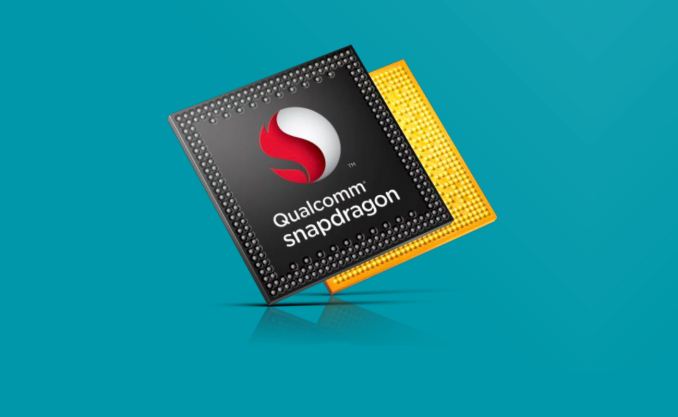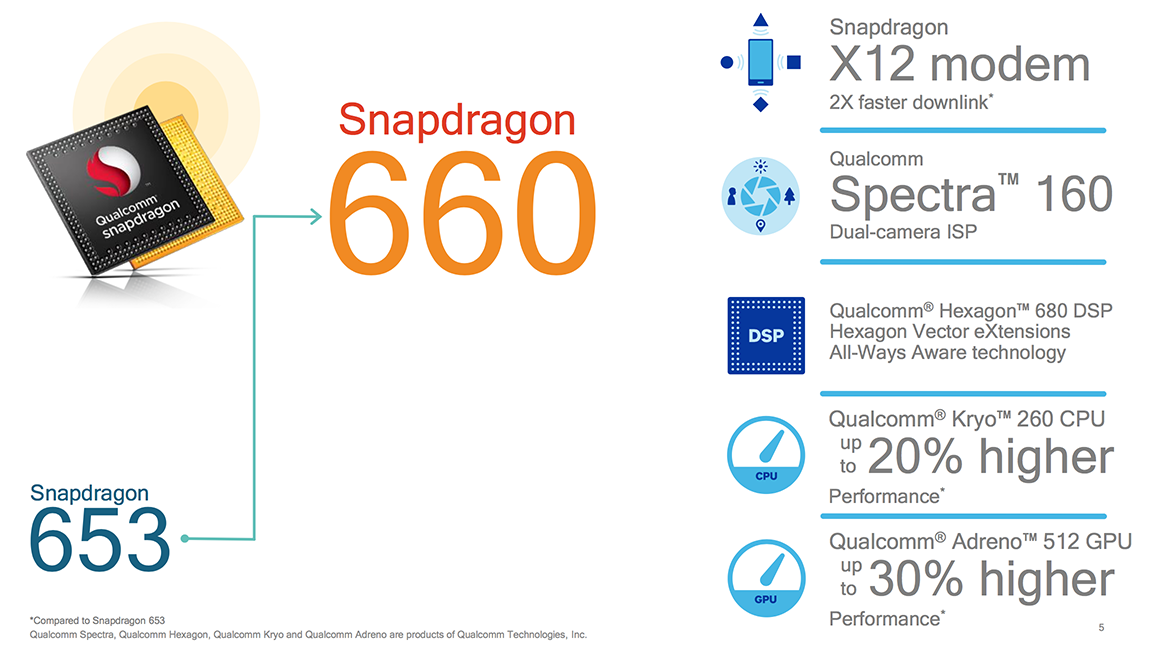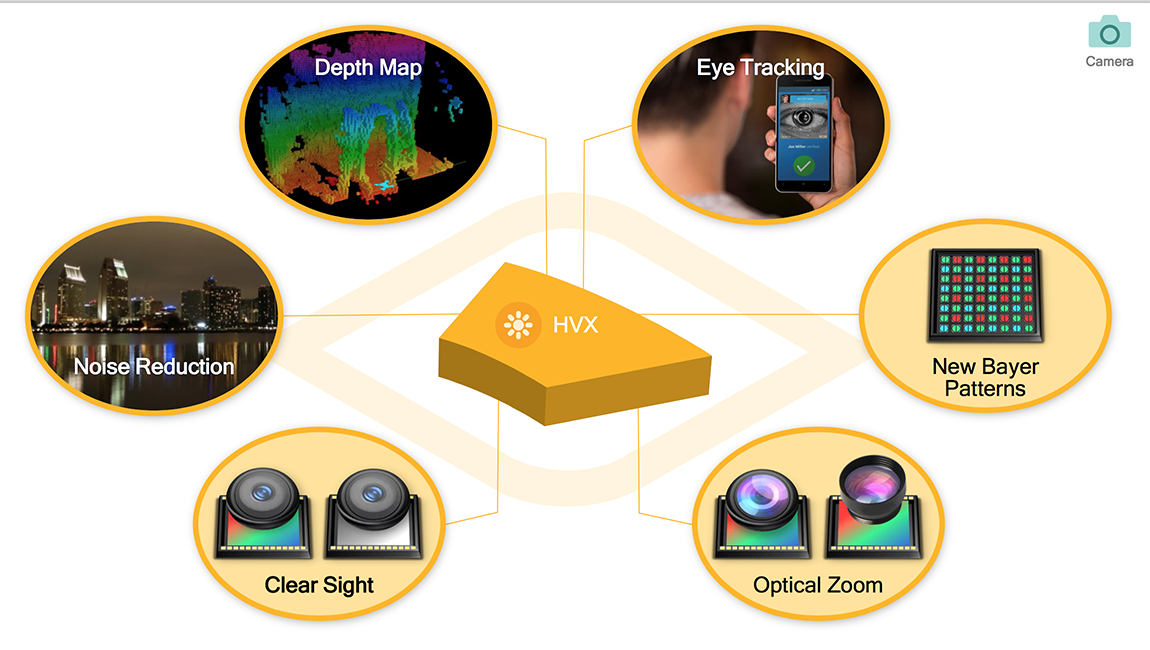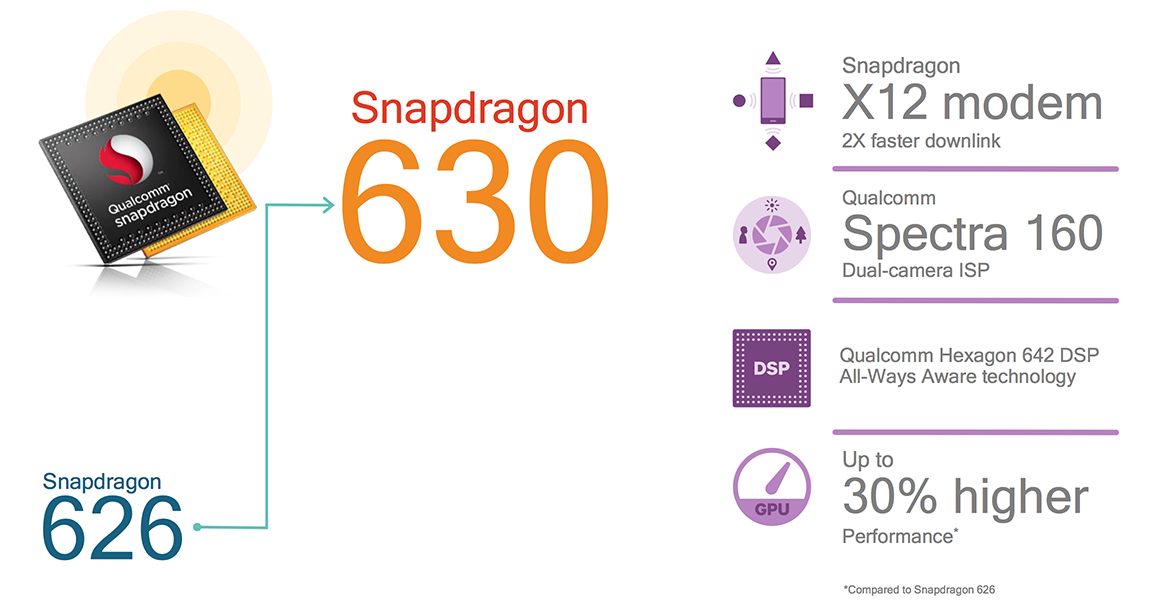Qualcomm Announces Snapdragon 660 & 630 Mobile Platforms: Better Connectivity, Camera, & Compute at 14nm
by Matt Humrick on May 8, 2017 10:00 PM EST
Qualcomm is bringing some premium experiences to its mid-tier lineup with the addition of the Snapdragon 660 and Snapdragon 630 Mobile Platforms. Improved connectivity, enhanced imaging, faster charging, and even machine learning features, in addition to the usual CPU and GPU improvements, help make these 600-series parts particularly interesting.
Qualcomm has been aggressively pushing more advanced LTE modems throughout its product portfolio recently, giving at least some of the SoCs in the 600 and even 400 tiers a minimum of Category 7 LTE performance (300Mbps DL / 100Mbps UL) with a Snapdragon X8 LTE modem. But after the debut of Qualcomm’s first gigabit LTE modem—the Snapdragon X16 (1.0Gbps DL / 150Mbps UL)—in the Snapdragon 835 SoC this year, along with its successor the Snapdragon X20 (1.2Gbps DL / 150Mbps UL), Qualcomm is ready to bring even higher performance to its new 600-series platforms. Both the Snapdragon 660 and Snapdragon 630 get the same Snapdragon X12 LTE modem that appeared in last year’s flagship Snapdragon 820/821 SoCs. This is a Category 12/13 modem capable of up to 600Mbps throughput on the downlink (3x20MHz CA, 256-QAM) and 150Mbps on the uplink (2x20MHz CA, 64-QAM).
Both the Snapdragon 660 and 630 platforms also support Qualcomm’s suite of RF front-end components too, including TruSignal adaptive antenna tuning with carrier aggregation, which dynamically optimizes signal quality to deliver better voice and data, and envelope tracking technology, which improves battery life and lowers skin temperature by improving power amplifier efficiency. There’s also support for high-power user equipment (HPUE) that helps extend network coverage, and is currently being used by Sprint.
| Qualcomm Snapdragon Upper Mid-Range SoCs | ||||
| SoC | Snapdragon 650 (MSM8956) |
Snapdragon 652 (MSM8976) |
Snapdragon 653 (MSM8976 Pro) |
Snapdragon 660 |
| CPU | 2x Cortex-A72 @ 1.80GHz 4x Cortex-A53 @ 1.44GHz |
4x Cortex-A72 @ 1.80GHz 4x Cortex-A53 @ 1.44GHz |
4x Cortex-A72 @ 1.95GHz 4x Cortex-A53 @ 1.44GHz |
4x Kryo 260 Performance @ 2.2GHz 4x Kryo 260 Efficiency @ 1.8GHz |
| GPU | Adreno 510 | Adreno 512 | ||
| DSP | Hexagon DSP All-Ways Aware Hub |
Hexagon 680 DSP All-Ways Aware Hub |
||
| ISP/ Camera |
Dual ISP 21MP |
Dual 14-bit Spectra 160 ISP 24MP |
||
| Memory | 2x 32-bit @ 933MHz LPDDR3 14.9GB/s |
2x 32-bit @ 1866MHz LPDDR4 29.9GB/s |
||
| Integrated Modem | Snapdragon X8 LTE (Category 7) DL = 300Mbps 2x20MHz CA, 64-QAM UL = 100Mbps 2x20MHz CA, 16-QAM |
Snapdragon X9 LTE (Category 7/13) DL = 300Mbps 2x20MHz CA, 64-QAM UL = 150Mbps 2x20MHz CA, 64-QAM |
Snapdragon X12 LTE (Category 12/13) DL = 600Mbps 3x20MHz CA, 256-QAM UL = 150Mbps 2x20MHz CA, 64-QAM |
|
| Encode/ Decode |
2160p30, 1080p120 H.264 & H.265 |
2160p30, 1080p120 H.264 & H.265 |
||
| Mfc. Process | 28nm HPm | 14nm LPP | ||
Another shared component between the Snapdragon 660 and 630 is the Spectra 160 ISP. While a step down in processing performance from the Spectra 180 ISP in Snapdragon 835, it still supports many of the same features, including hybrid autofocus systems, dual photodiode phase-detect autofocus (2PDAF), better electronic image stabilization for video, and enhanced low-light processing for still images. It can also handle dual-camera setups with Qualcomm’s smooth “optical zoom” feature when using two cameras with different focal lengths. It can also integrate data from both cameras to produce bokeh effects or to improve image quality.
Another advanced feature supported by the Snapdragon 660 and 630 is Qualcomm’s Quick Charge 4 fast-charging technology, which was previously only available with Snapdragon 835. Quick Charge 4 promises up to 20% faster charging and 30% higher efficiency than the previous generation Quick Charge 3.
The Snapdragon 660, which is a replacement for the Snapdragon 653, is now the highest performing SoC in the 600-series. Like the Kryo 280 in Snapdragon 835, the Snapdragon 660’s Kryo 260 CPU uses four semi-custom Cortex-A73 cores in the “performance” cluster and four semi-custom Cortex-A53 cores in the “efficiency” cluster in a big.LITTLE arrangement. The Kryo 260, however, does not hit the same peak frequencies as Kryo 280, and Kryo 260 uses 1MB/1MB of shared L2 per cluster instead of 2MB/1MB of L2 for Kryo 280. We’ve already seen how well Snapdragon 835 performs, and Snapdragon 660 should not be too far behind.
Alongside the Kryo 260 CPU is the Adreno 512 GPU that delivers up to 30% better performance on average than the Adreno 510 GPU in Snapdragon 653, according to Qualcomm. Some of the gain likely comes from a frequency increase (perhaps a lot of it), but it’s still a pretty significant jump, although it should still fall below the peak performance of the Adreno 530 GPU in Snapdragon 820. It supports the latest 3D graphics APIs, including Vulkan, and can power displays with up to 2560x1600 resolution.
Another significant addition to Snapdragon 660 is Qualcomm’s Hexagon 680 DSP, which made its debut last year in the Snapdragon 820 SoC and features Hexagon Vector eXtensions (HVX) specifically designed for advanced photo and video processing, virtual reality, and computer vision workloads. This DSP can work on two vector threads in parallel, each containing four 1024-bit SIMD pipelines (a typical ARM CPU core contains two 128-bit SIMD NEON vector pipelines for comparison), allowing each HVX context to work on 4,096 bits/cycle compared to 256 bits/cycle for a single CPU core. The Hexagon 680 also contains four threads for scalar instructions too, each with 4 VLIW pipelines. Using up to two scalar threads and two vector threads in parallel allows concurrent execution of audio and imaging tasks.
The Snapdragon 660 supports Qualcomm’s Snapdragon Neural Processing Engine SDK, along with TensorFlow and Halide frameworks on the Hexagon 680 DSP, bringing advanced machine learning and computer vision capabilities to the 600-tier for the first time.
| Qualcomm Snapdragon Mid-Range SoCs | ||||
| SoC | Snapdragon 615 / 616 (MSM8939) |
Snapdragon 617 (MSM8952) |
Snapdragon 625 / 626 (MSM8953 / MSM8953 Pro) |
Snapdragon 630 |
| CPU | 4x Cortex-A53 @ 1.70GHz 4x Cortex-A53 @ ? |
4x Cortex-A53 @ 1.50GHz 4x Cortex-A53 @ ? |
4x Cortex-A53 @ 2.00GHz / 2.20GHz 4x Cortex-A53 @ 2.00GHz / 2.20GHz |
4x Cortex-A53 @ 2.2GHz 4x Cortex-A53 @ 1.8GHz |
| GPU | Adreno 405 | Adreno 506 | Adreno 508 | |
| DSP | Hexagon DSP | Hexagon DSP All-Ways Aware Hub |
Hexagon 642 DSP All-Ways Aware Hub |
|
| ISP/ Camera |
21MP | Dual ISP 24MP |
Dual 14-bit Spectra 160 ISP 24MP |
|
| Memory | 1x 32-bit @ 800MHz LPDDR3 6.4GB/s |
1x 32-bit @ 933MHz LPDDR3 7.46GB/s |
2x 16-bit @ 1333MHz LPDDR4 10.66GB/s |
|
| Storage | eMMC 4.51 | eMMC 5.1 | eMMC 5.1 | eMMC / UFS |
| Integrated Modem | Gobi 4G LTE / Snapdragon X5 LTE (Category 4) DL = 150Mbps 1x20MHz CA, 64-QAM UL = 50Mbps 1x20MHz CA, 16-QAM |
Snapdragon X8 LTE (Category 7) DL = 300Mbps 2x20MHz CA, 64-QAM UL = 100Mbps 2x20MHz CA, 16-QAM |
Snapdragon X9 LTE (Category 7/13) DL = 300Mbps 2x20MHz CA, 64-QAM UL = 150Mbps 2x20MHz CA, 64-QAM |
Snapdragon X12 LTE (Category 12/13) DL = 600Mbps 3x20MHz CA, 256-QAM UL = 150Mbps 2x20MHz CA, 64-QAM |
| Encode/ Decode |
1080p30 H.264 / 1080p60 H.264 & H.265 |
2160p30 H.264 & H.265 |
2160p30, 1080p120 H.264 & H.265 |
|
| Mfc. Process | 28nm LP | 14nm LPP | ||
The Snapdragon 630 SoC uses a familiar octa-core Cortex-A53 CPU configuration. Unlike the Snapdragon 625/626 that it replaces, the Snapdragon 630 has a more distinct big.LITTLE arrangement with four A53s running at up to 2.2GHz (the same as the S626) sharing a 1MB L2 cache and four more A53s only reaching up to 1.8GHz and sharing a smaller 512KB L2 cache. While there should not be much difference in CPU performance and power compared to the Snapdragon 626, the Snapdragon 630’s Adreno 508 GPU performs 30% better on average than the S626’s Adreno 506 GPU. It also supports Vulkan and all of the latest 3D graphics APIs at resolutions up to 1920x1200. The Hexagon 642 DSP still supports Qualcomm’s Snapdragon Neural Processing Engine SDK for machine learning and TensorFlow, but does not share the Hexagon Vector eXtensions (HVX) microarchitecture of the more powerful Hexagon 680 and 682 DSPs.
Both of the new Snapdragon 660 and 630 platforms include features and capabilities previously seen only in the premium 800-tier, and also add new technologies like Bluetooth 5 and LPDDR4 RAM support (up to 8GB), which reduces power consumption and improves bandwidth compared to LPDDR3. The Snapdragon 660 sounds particularly compelling, because it appears to deliver a very similar experience to last year’s Snapdragon 820 but, presumably, at a lower price point.
The Snapdragon 660 and 630 platforms are pin and software compatible, and they both use the same 14nm LPP FinFET process from Samsung. The Snapdragon 660 is available to partners now and should appear in devices during the second quarter, while the Snapdragon 630 will become available at the end of May and is expected to appear in devices during the third quarter.













59 Comments
View All Comments
Suraj tiwari - Tuesday, May 9, 2017 - link
I don't think snapdragon 660 incorporate a A73 processor, i think it's still A72 and A53.Lodix - Tuesday, May 9, 2017 - link
There is no point in using A72 over A73 because the new architecture is smaller/cheaper.Suraj tiwari - Wednesday, May 10, 2017 - link
@ LodixA73 is not cheaper, it just takes up less silicon die space than A72 core, so it reduces the 'SOC manufacturer' cost but a Licensee has to pay more on every A73 core produced or modified vs A72 core, as A73 is a newer core.
Why I am saying that it is still A72 and A53 is because- snapdragon 660 only provide 20% improvement in cpu performance compared to 653, given that it has transitioned from HPM to FinFet, 28nm to 14nm, ARM A72 to custom core 'kryo 260', It should give 20% performance improvement, if based on A72 core, and at least 30% increase in performance, if based on A73 core.
( Note: A73 core provide upto 15% increase in performance when implemented on same process node and upto 30% improvement in performance when implemented on 10nm process node as compared to an A72 core ).
LiverpoolFC5903 - Wednesday, May 10, 2017 - link
Where did you get this information from? From what I recall, the A73 is barely ~10% faster than the A72 overall at the same process node and clock speed, and actually slower in many tasks.Suraj tiwari - Wednesday, May 10, 2017 - link
@LiverpoolFC590310% in general performance + 5% in SIMD Multimedia operations = 15%
Here is the link of the site-http://www.androidauthority.com/arm-cortex-a73-gar...
I have read, probably ( i am not sure), that A73 is better than A72 in integer operations but perform worse in floating-point operations. You have said A73 is slower in many tasks, can you elaborate?
Matt Humrick - Wednesday, May 10, 2017 - link
I've already proven that the big semi-custom cores in Kryo 2xx are based on the Cortex-A73: http://www.anandtech.com/show/11201/qualcomm-snapd...Suraj tiwari - Wednesday, May 10, 2017 - link
Matt HumrickYeah, i just browsed that URL and it was about snapdragon 835 and its 'kryo 280' core but i am talking about snapdragon 660 and its 'kryo 260' core. Did you test this one ('kryo 260' core)? If 'kryo 280' is based on A73 core, it does not mean that all 'kryo 2xx' will be based on A73 core as well. If it is really based on A73 core, then why 'only 20%' performance improvement in cpu as compared to snapdragon 653, given that it has transitioned from HPM to FinFet, 28nm to 14nm, ARM A72 to custom core 'kryo 260'. Will you test 'kryo 260' in coming days?
zodiacfml - Tuesday, May 9, 2017 - link
Interesting but I expect manufacturers utilize the SD660 then price these phones at flagship pricesserendip - Tuesday, May 9, 2017 - link
Xiaomi and smaller Chinese brands used the 65x in their midrange devices that could have cannibalized flagship sales. Only Samsung charged premium prices for a midrange 650 on their Galaxy A9 Pro.zodiacfml - Tuesday, May 9, 2017 - link
Interesting but I expect manufacturers utilize the SD660 then price these phones at flagship prices